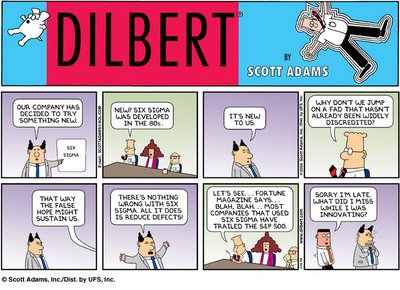
Our new CEO is a real fan of software to run his business. So far he has chosen to foist off the responsibility for getting it installed and operating to first one then another manager, consultant, or it seems at times, to no one at all as the issue has dribbled along for the past 3-4 years. Has anyone heard him articulate just what he wants to do other than to punch a few keys on his computer and get financial reports and future sales (really!) reports, and whatever other kind of reports he can dream up from one day to the next? Does he really know what he wants to do?
Perhaps the following discussion about ERP software throws some light on his experiment. It is an article from Wikipedia that appears to be written by someone who, unlike our CEO, knows what he is talking about. Note the list of "advantages" vs. "disadvantages" at the end of the article. The score is 6 pro vs. 16 con and that the ERP system appears to be more suited to a manufacturing operation than a contracting business. Maybe Johnnie missed that little detail before spreading the pain he has said he likes to send downstream.
By installing an ERP system and placing his two top direct reports into their positions just below him, each of them functionally computer illiterate, he has taken a big step toward ensuring that the owner would have a difficult time replacing him, even in view of the fact that he has failed to make his initial targets or for that matter, any money whatsoever since he arrived nearly 5-years ago. Anyone else experiencing frozen salaries, little or no bonuses, and how about those non-existent annual reviews?
Enterprise resource planning
Enterprise Resource Planning systems (ERPs) integrate (or attempt to integrate) all data and processes of an organization into a unified system. A typical ERP system will use multiple components of computer software and hardware to achieve the integration. A key ingredient of most ERP systems is the use of a unified database to store data for the various system modules. The term ERP originally implied systems designed to plan the utilization of enterprise-wide resources. Although the acronym ERP originated in the manufacturing environment, today's use of the term ERP systems has much broader scope. ERP systems typically attempt to cover all basic functions of an organization, regardless of the organization's business or charter. Business, non-profit organizations, non governmental organizations, governments, and other large entities utilize ERP systems.
Additionally, it may be noted that to be considered an ERP system, a software package generally would only need to provide functionality in a single package that would normally be covered by two or more systems. Technically, a software package that provides both Payroll and Accounting functions (such as QuickBooks) would be considered an ERP software package.
However, the term is typically reserved for larger, more broadly based applications. The introduction of an ERP system to replace two or more independent applications eliminates the need for external interfaces previously required between systems, and provides additional benefits that range from standardization and lower maintenance (one system instead of two or more) to easier and/or greater reporting capabilities (as all data is typically kept in one database).
Examples of modules in an ERP which formerly would have been stand-alone applications include: Manufacturing, Supply Chain, Financials, CRM, Human Resources, and Warehouse Management.
Overview
Looking more closely at ERP systems, a key factor is the integration of data from all aspects of an organization. To accomplish this, an ERP system typically runs on a single database instance with multiple software modules providing the various business functions of an organization.
Some organizations - typically those with sufficient in-house IT skills to integrate multiple software products - choose to only implement portions of an ERP system and develop an external interface to other ERP or stand-alone systems for their other application needs. For instance, the PeopleSoft HRMS and Financials systems may be perceived to be better than SAP's HRMS solution. And likewise, some may perceive SAP's manufacturing and CRM systems as better than PeopleSoft's equivalents. In this case these organizations may justify the purchase of an ERP system, but choose to purchase the PeopleSoft HRMS and Financials modules from Oracle, and their remaining applications from SAP.
This is very common in the retail sector, where even a mid-sized retailer will have a discrete Point-of-Sale (POS) product and financials application, then a series of specialised applications to handle business requirements such as warehouse management, staff rostering, merchandising and logistics.
Ideally, ERP delivers a single database that contains all data for the software modules, which would include:
Manufacturing
Engineering, Bills of Material, Scheduling, Capacity, Workflow Management, Quality Control, Cost Management, Manufacturing Process, Manufacturing Projects, Manufacturing Flow
Supply Chain Management
Inventory, Order Entry, Purchasing, Product Configurator, Supply Chain Planning, Supplier Scheduling
Financials
General Ledger, Cash Management, Accounts Payable, Accounts Receivable, Fixed Assets
Projects
Costing, Billing, Time and Expense, Activity Management
Human Resources
Human Resources, Payroll, Training, Time & Attendance, Benefits
Customer Relationship Management
Sales and Marketing, Commissions, Service, Customer Contact and Call Center support
Data Warehouse
and various Self-Service interfaces for Customers, Suppliers, and Employees
Enterprise Resource Planning is a term originally derived from manufacturing resource planning (MRP II) that followed material requirements planning (MRP). MRP evolved into ERP when "routings" became major part of the software architecture and a company's capacity planning activity also became a part of the standard software activity. ERP systems typically handle the manufacturing, logistics, distribution, inventory, shipping, invoicing, and accounting for a company. Enterprise Resource Planning or ERP software can aid in the control of many business activities, like sales, marketing, delivery, billing, production, inventory management, quality management, and human resources management.
ERPs are often incorrectly called back office systems indicating that customers and the general public are not directly involved. This is contrasted with front office systems like customer relationship management (CRM) systems that deal directly with the customers, or the eBusiness systems such as eCommerce, eGovernment, eTelecom, and eFinance, or supplier relationship management (SRM) systems.
ERPs are cross-functional and enterprise wide. All functional departments that are involved in operations or production are integrated in one system. In addition to manufacturing, warehousing, logistics, and Information Technology, this would include accounting, human resources, marketing, and strategic management.
ERP II means open ERP architecture of components. The older, monolithic ERP systems became component oriented.
EAS - Enterprise Application Suite is a new name for formerly developed ERP systems which include (almost) all segments of business, using ordinary Internet browsers as thin clients.
Before
Prior to the concept of ERP systems, departments within an organization would have their own computer systems. For example, the Human Resources (HR) department, the Payroll (PR) department, and the Financials department. The HR computer system (Often called HRMS or HRIS) would typically contain information on the department, reporting structure, and personal details of employees. The PR department would typically calculate and store paycheck information. The Financials department would typically store financial transactions for the organization. Each system would have to rely on a set of common data to communicate with each other. For the HRIS to send salary information to the PR system, an employee number would need to be assigned and remain static between the two systems to accurately identify an employee. The Financials system was not interested in the employee level data, but only the payouts made by the PR systems, such as the Tax payments to various authorities, payments for employee benefits to providers, and so on. This provided complications. For instance, a person could not be paid in the Payroll system without an employee number.
After
ERP software, among other things, combined the data of formerly disparate applications. This made the worry of keeping employee numbers in synchronization across multiple systems disappear. It standardised and reduced the number of software specialties required within larger organizations.
Best Practices
Best Practices were also a benefit of implementing an ERP system. When implementing an ERP system, organizations essentially had to choose between customizing the software or modifying their business processes to the "Best Practice" functionality delivered in the vanilla version of the software.
Typically, the delivery of best practice applies more usefully to large organizations and especially where there is a compliance requirement such as IFRS, Sarbanes-Oxley or Basel II, or where the process is a commodity such as electronic funds transfer. This is because the procedure of capturing and reporting legislative or commodity content can be readily codified within the ERP software, and then replicated with confidence across multiple businesses who have the same business requirement.
Where such a compliance or commodity requirement does not underpin the business process, it can be argued that determining and applying a best practice actually erodes competitive advantage by homogenizing the business compared to everyone else in their industry sector.
Evidence for this can be seen within EDI, where the concept of best practice, even with decades of effort remains elusive. A large retailer, for example, wants EDI plus some minor tweak that they perceive puts them ahead of their competition. Mid-market companies adopting ERP often take the vanilla version and spend half as much as the license cost doing customisations that deliver their competitive edge. In this way they actively work against best practice because they perceive that the way they operate is best practice, irrespective of what anyone else is doing.
Implementation
Because of their wide scope of application within a business, ERP software systems are typically complex and usually impose significant changes on staff work practices (if they did not, there would be little need to implement them). Implementing ERP software is typically not an "in-house" skill, so even smaller projects are more cost effective if specialist ERP implementation consultants are employed. The length of time to implement an ERP system depends on the size of the business, the scope of the change and willingness of the customer to take ownership for the project. A small project (eg, a company of less than 100 staff) may be planned and delivered within 3 months; however, a large, multi-site or multi-country implementation may take years.
The most important aspect of any ERP implementation is that the company who has purchased the ERP product takes ownership of the project.
To implement ERP systems, companies often seek the help of an ERP vendor or of third-party consulting companies. These firms typically provide three areas of professional services: Consulting, Customisation and Support.
Consulting Services
The Consulting team is typically responsible for your initial ERP implementation and subsequent delivery of work to tailor the system beyond "go live". Typically such tailoring includes additional product training; creation of process triggers and workflow; specialist advice to improve how the ERP is used in the business; system optimisation; and assistance writing reports, complex data extracts or implementing Business Intelligence.
The consulting team are also responsible for planning and jointly testing the implementation. This a critical part of the project, and one that is often overlooked.
Consulting for a large ERP project involves three levels: systems architecture, business process consulting (primarily re-engineering) and technical consulting (primarily programming and tool configuration activity). A systems architect designs the overall dataflow for the enterprise including the future dataflow plan. A business consultant studies an organization's current business processes and matches them to the corresponding processes in the ERP system, thus 'configuring' the ERP system to the organization's needs. Technical consulting often involves programming. Most ERP vendors allow modification of their software to suit the business needs of their customer.
For most mid-sized companies, the cost of the implementation will range from around the the list price of the ERP user licenses to up to twice this amount (depending on the level of customisation required). Large companies, and especially those with multiple sites or countries, will often spend considerably more on the implementation than the cost of the user licenses -- three to five times as more is not uncommon for a multi-site implementation.
Customisation Services
Customisation is the process of extending or changing how the system works by writing new user interfaces and underlying application code. Such customisations typically reflect local work practices that which are not currently in the core routines of the ERP system software.
Examples of such code include early adopter features (e.g., mobility interfaces were uncommon a few years ago and were typically customised) or interfacing to third party applications (this is 'bread and butter' customisation for larger implementations as there are typically dozens of ancilliary systems that the core ERP software has to interact with). The Professional Services team is also involved during ERP upgrades to ensure that customisations are compatible with the new release. In some cases the functionality delivered via previous a customisation may have been subsequently incorporated into the core routines of the ERP software, allowing customers to revert back to standard product and retire the customisation completely.
Customizing an ERP package can be very expensive and complicated, because many ERP packages are not designed to support customization, so most businesses implement the best practices embedded in the acquired ERP system. Some ERP packages are very generic in their reports and inquiries, such that customization is expected in every implementation. It is important to recognize that for these packages it often makes sense to buy third party plug-ins that interface well with your ERP software rather than reinventing the wheel.
Customisation work is usually undertaken as bespoke software development on a time and materials basis. Because of the specialist nature of the customisation and the 'one off' aspect of the work, it is common to pay in the order of $200 per hour for this work. Also, in many cases the work delivered as customisation is not covered by the ERP vendors Maintenance Agreement, so while there is typically a 90-day warranty against software faults in the custom code, there is no obligation on the ERP vendor to warrant that the code works with the next upgrade or point release of the core product.
One often neglected aspect of customisation is the associated documentation. While it can seem like a considerable -- and expensive -- overhead to the customisation project, it is critical that someone is responsible for the creation and user testing of the documentation. Without the description on how to use the customisation, the effort is largely wasted as it becomes difficult to train new staff in the work pratice that the customisation delivers.
Maintenance and Support Services
Once your system has been implemented, the consutling company will typically enter into a Support Agreement to assist your staff keep the ERP software running in an optimal way. A Maintenance Agreement typically provides you rights to all current version patches, and both minor and major releases, and will most likely allow your staff to raise support calls. While there is no standard cost for this type of agreement, they are typically between 15% and 20% of the list price of the ERP user licenses.
Advantages
In the absence of an ERP system, a large manufacturer may find itself with many software applications that do not talk to each other and do not effectively interface. Tasks that need to interface with one another may involve:
- design engineering (how best to make the product)
- order tracking from acceptance through fulfillment
- the revenue cycle from invoice through cash receipt
- managing interdependencies of complex Bill of Materials
- tracking the 3-way match between Purchase orders (what was ordered), Inventory receipts (what arrived), and Costing (what the vendor invoiced)
- the Accounting for all of these tasks, tracking the Revenue, Cost and Profit on a granular level.
Change how a product is made, in the engineering details, and that is how it will now be made. Effective dates can be used to control when the switch over will occur from an old version to the next one, both the date that some ingredients go into effect, and date that some are discontinued. Part of the change can include labeling to identify version numbers.
Computer security is included within an ERP to protect against both outsider crime, such as industrial espionage, and insider crime, such as embezzlement. A data tampering scenario might involve a terrorist altering a Bill of Materials so as to put poison in food products, or other sabotage. ERP security helps to prevent abuse as well.
Disadvantages
Many problems organizations have with ERP systems are due to inadequate investment in ongoing training for involved personnel, including those implementing and testing changes, as well as a lack of corporate policy protecting the integrity of the data in the ERP systems and how it is used.
Limitations of ERP include:
- Success depends on the skill and experience of the workforce, including training about how to make the system work correctly. Many companies cut costs by cutting training budgets. Privately owned small enterprises are often undercapitalized, meaning their ERP system is often operated by personnel with inadequate education in ERP in general, such as APICS foundations, and in the particular ERP vendor package being used.
- Personnel turnover; companies can employ new managers lacking education in the company's ERP system, proposing changes in business practices that are out of synchronization with the best utilization of the company's selected ERP.
- Customization of the ERP software is limited. Some customization may involve changing of the ERP software structure which is usually not allowed.
- Re-engineering of business processes to fit the "industry standard" prescribed by the ERP system may lead to a loss of competitive advantage.
- ERP systems can be very expensive to install.
- ERP vendors can charge sums of money for annual license renewal that is unrelated to the size of the company using the ERP or its profitability.
- Technical support personnel often give replies to callers that are inappropriate for the caller's corporate structure. Computer security concerns arise, for example when telling a non-programmer how to change a database on the fly, at a company that requires an audit trail of changes so as to meet some regulatory standards.
- ERPs are often seen as too rigid and too difficult to adapt to the specific workflow and business process of some companies - this is cited as one of the main causes of their failure.
- Systems can be difficult to use.
- The system can suffer from the "weakest link" problem - an inefficiency in one department or at one of the partners may affect other participants.
- Many of the integrated links need high accuracy in other applications to work effectively. A company can achieve minimum standards, then over time "dirty data" will reduce the reliability of some applications.
- Once a system is established, switching costs are very high for any one of the partners (reducing flexibility and strategic control at the corporate level).
- The blurring of company boundaries can cause problems in accountability, lines of responsibility, and employee morale.
- Resistance in sharing sensitive internal information between departments can reduce the effectiveness of the software.
- There are frequent compatibility problems with the various legacy systems of the partners.
- The system may be over-engineered relative to the actual needs of the customer.
 Is there any question that Jim Lindsey and Bob Coleman went outside of the company to hire Dilbert's boss? John and his crew grew up in Six Sigma and now it is all they know. Are you concerned that you can't quite figure out what they are trying to do? Don't worry about it. They don't know either. That's why they have to cling to 15-20 year old jargon in order to keep you off balance, and to present a facade that they do know what they are doing. Flat to declining sales since John arrived speak loudly enough. Enough. Enough. Please, enough! LEFT CLICK THE PICTURE TO ENLARGE IT.
Is there any question that Jim Lindsey and Bob Coleman went outside of the company to hire Dilbert's boss? John and his crew grew up in Six Sigma and now it is all they know. Are you concerned that you can't quite figure out what they are trying to do? Don't worry about it. They don't know either. That's why they have to cling to 15-20 year old jargon in order to keep you off balance, and to present a facade that they do know what they are doing. Flat to declining sales since John arrived speak loudly enough. Enough. Enough. Please, enough! LEFT CLICK THE PICTURE TO ENLARGE IT.





